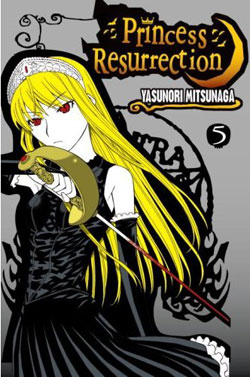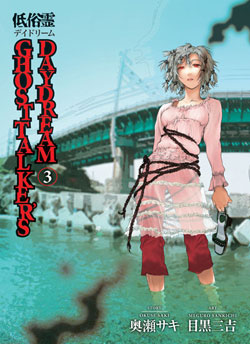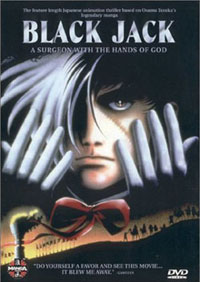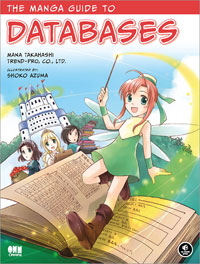 Logo handmade by Bannister
Column by Scott Green
Logo handmade by Bannister
Column by Scott Green
Win a Manga Guide...
Geek interest publisher No Starch Press has begun releasing the "Manga Guide To..." tech instructional books starting with The Manga Guide to Statistics (reviewed here) and The Manga Guide to Databases. These are light, enjoyable introductions or refreshers to their technical subjects, and if you're interested, AICN has a copy of each to give away. The Manga Guide to Statistics To win a copy, send an e-mail with you postal address, using the subject line "statistics" to animecontest@gmail.comThe Manga Guide to Databases To win a copy, send an e-mail with you postal address, using the subject line "databases" to animecontest@gmail.com A drawing will be held on March 1. Feel free to enter both, but only one prize will be awarded to a particular entrant. US residents only please.

Manga Spotlight: Princess Resurrection Volume 5 By Yasunori Mitsunaga Released by Del Rey
I've got to say, I thought that Princess Resurrection could do more with Day of the Dead... The manga is structured around the game of thrones played by the sibling heirs to the underworld. Lilianne, aka Hime (literally "Princess") and her siblings can resurrect undying "blood warriors," and augment these knights with cadres of other chess pieces from among the catalog of monster lore. Hime's chevalier is Hiro, a hapless, nondescript schoolboy. Then there's Flandre, a stubby Franken-maid, with a vocabulary limited to "hooba;" Riza Wildman, a frisky werewolf-girl with giant fluffy paw-mitts; and. Reiri Kamura, a haughty queen bee vampire school girl. This monster squad is inserted into scenarios inspired by horror movies in such a way as to showcase the laconic Hime, dressed in black gowns, going at foes with improbable weapons (far less exotic than most in this volume - only a foil) and showcasing perpetual victim Hiro staining the furniture with his blood (in this volume, a woman whose claw hand, bra and cloak ensemble evokes Shin Angyo Onshi:Blade of the Phantom Master's Sando slices him stem to stern). A shopping center besieged by hordes of shambling zombies should be ideal grist for this loligoth grind house. And, there are a number of quality scenes that capture the vein slicing playfulness of forcing a collision between a familiar horror concept and a selection manga character types. Hime, Hiro and Riza on a rooftop spying down on the masses of shopper turned zombies... the various species of shopping centered frequenters, bleeding and zombified, Hime looking imperious... Riza looking impatient... it captures the perfect note of "let the bickering and Hiro brain munching begin!" A zombie-Honda-minivan suicide attack results in a nice, well rendered two page spread of twisted metal. And, Hime's kid sister Sherwood steals the show. Panels of her Triffids tossing zombies or a bespectacled, slender, formal looking robot maid with an undead panda balanced on her shoulders, and Sherwood at the top of the bizarre totem pole, constitutes the kind of stacked oddity that makes Princess Resurrection a delight. What's disappointing about how Mitsunaga handles the situation is that there isn't much in the way of clever interaction between the heroes and the zombies. Mitsunaga does establish an arc for the encounter. Hime and company are lured to Zombie-ville. They're beaten up by the shirtless blood warrior. Tools for dealing with zombies are removed. Then, it's time to batter down and fend off the zombies. A key restriction for how this needs to play out is that Mitsunaga is far better at sticking single panels than at dynamic fights. The manga depicts pages of zombies swarming human bystanders or Riza with a pipe, swatting the undead, but the artist's forte is less making this sort of connected, dynamic action than it is sudden or explosive spectacles. In this Romero meets manga situation, you want the character pinned down for a while. A sudden onslaught should do something gruesome to Hiro. Finally, when the heroes do turn the tide, it should be done in some staggering outlandish and/or overkill manner. Yet, while a plot point is made of how unleashing a horde of zombies is a transgressive tactic in the war between Hime and her siblings, nothing memorable comes out of the interaction between Hime's team and the zombies. While the volume did have a number of impressive images, their subject was focused on Hime and her crew, Sherwood and her team or the zombies rather than an interaction between the parties. For a manga series that I've regarded as surprisingly fun, working from a situation that I expected to be fertile ground for what the manga does well, Princess Resurrection proved to be surprisingly underwhelming.

Manga Spotlight: Ghost Talker’s Daydream Volume 3 Writer: Saki Okuse Artist: Sankichi Meguro
I've picked up slightly more respect for Ghost Talker’s Daydream's cocktail of salacious sex, tragic violence, and what's been labeled "J-horror" (or "dead wet girls") when depicted in film. An alternative translation of the manga's title, Teizokurei Daydream, is Vulgar Ghost Daydream. It's a pun, but the notion of vulgarity is certainly not alien to the manga, which is packed with sex, violence and sexual violence. Yet, the problem that I have with the manga is that I don't trust its ability to smartly navigate between what's appropriate and what's purposefully offensive. It wouldn't be as much a problem if the manga was simply exploitative, but instead, it falls into a challenging middle ground. In previous reviews I've express some ambivalence about how aspects of Ghost Talker's Daydream fit together. The first part of revered manga creator Osamu Tezuka's self declared life's work, Phoenix, opens in the Yamataikoku period of Japanese history, around 300 CE. A woman falls for a kind, intelligent stranger who her tribe picked out the sea and resuscitates. On the night of their marriage, he climes to a rock cliff, and begins waving a pair of torches. There's an incredible cinematic sequence, the sea fills with dots of light in response. An invasion commences, and the woman's tribe is slaughtered. Torn up in grief, she climes up a nearby mountain, and proclaims that she'll kill herself. Her traitorous husband catches up with her and tries to reason with the woman who he does, in fact love. Just then, the mountain itself seems to revolt, spouting out a geyser. The woman is swept up in the scolding water. The husband dives in after her.... In the midst of this tense moment, who does the man see in the deadly torrent? Osamu Tezuka himself, drawn into the panel, relaxing in the steaming brew. It's a staggeringly goofy gag at odds with the pitched, life and death moment. Point being, manga has a venerable tradition of mixing tones, sometimes in a moment's pivot. This can be seen in the structure of a series that doesn't paint itself in a uniform shade of storytelling. Eden: It's an Endless World goes from salon philosophy to robots and mutants, to street level drug cartel violence, to sex comedy. Then, there's manga that breaks one type of scene with another, along the lines to the Tezuka gag insert. A comedy like Love Hina turns into straight drama for a moment. A Yu Yu Hakusho fight scene goes goofy for a instant. This sort of modulation is fundamental to Ghost Talker's Daydream. Its heroine Misaki Saiki is a dominatrix by night - consultant medium by night. While she's less embarrassed by the former than the latter, the manga largely treats role of dominatrix as a joke and the psychic work as the serious core of the manga. The way that this manga is written, some ideas are inherently humorous and some are inherently dramatic. Sadomashism, pubic hair and lack thereof, virginity, alcohol abuse... funny. Death, family relationships, sexual assault ... dramatic. For a messy manga, soaked in bodily fluids and tortured relationships, Ghost Talker’s Daydream has an uncomplicated a regard for how things fit together. The first story in volume 3, "Coming Out" deals with drug use, homosexual relationships, gender identity disorder and suicide. My immediate reaction... I hope the manga treads carefully.... Shizue Mikuriya, a magazine editor/model who has worked with Misaki in her capacity as a dominatrix, opens the story in bed with a drug addled young woman. When Shizue end leaves the bed, the girl starts weeping "who the fuck stops when they discover they're with a virgin? Especially a lesbian?!" Shizue kisses the girl and responds "it's not that I don't find you attractive. You're the one who said you're not sure if you're a lesbian or not." Then, she thinks to herself "I'll have to make sure this runaway finds her way home before summer vacation ends." "Coming Out" builds to a shockingly sexualized scene of a naked, sinewy spirit wrapping its elongated limbs around a woman that is appropriately disturbing. It's less punctuated by ill conceived goofiness than a Ghost Talker's Daydream story which dismounts from a sweet parable about a family's death transcendent love with a hymen joke and a manic nose bleed face fault. Yet, the story does underscore my apprehension with the manga series, and especially its oscillation between comedy and tragedy. Touching upon sexual assault, sexual hang-ups or sexual identity this is manga that plays with fire... Some of its incendiary issues are played for laughs, some are intended to be shocking, and some are treated humanly, and the manga has yet to earn my trust as to whether it'll be sensible about choosing which path to pursue. The problem is that I don't get the read that Okuse and Meguro have deeply considered what they're depicting. I don't get the sense that they've considered what work as a dominatrix entails. I think they decided that it's a humorous occupation and accordingly treated it as a joke. I don't get the sense that they familiarized themselves with the dynamics of what happens in a lesbian bar. I think they invented a scenario that would link the right alienated personalities, suitable for a ghost story. Once they have these notions of story elements like a dominatrix or a lesbian, the manga creators drop them down like dominos. Here's a lesbian that'll get you to the tormented soul to haunt the story. Here's a gag about looking up a short skirt, connected to a look into a dumpy apartment in which a man hung himself. I get what the creators are trying to do, but I question the wisdom.
Highlight from New York Comic Con
Be sure to stop by Friday for (hopefully) a Afro Samurai: Resurrection reviews, and plenty of cool stuff from the news front, but to get in some highlights... Yatsuba&! Many manga readers have been lamenting ADV Manga's aborted release of Kyohiko Azuma's comedy Yotsuba&! Reviewed hereAzumanga Daioh creator Kyohiko Azuma doesn’t play fair. If you're into cute, Yotsuba has it bottled. But, if you're not, he constructs a wide eyed whirling dervish orphan with too much insistent energy to deny. Some history here and here. Well, Yen Press has picked up the license plans to release volume six in September. The publisher will also be releasing the manga version of religion and trade focused fantasy Spice and Wolf. From Viz... VIZ Media will be releasing the still unnamed, upcoming working for Inu-Yasha creator Rumiko Takashi. Other coming manga releases include (scheduled for October 2009) What a wonderful world! by Inio Asano Yu-Gi-Oh! R Boys Over Flowers: Jewelry Box (epilogue to relationship manga) by Yoko Kamio (scheduled for November 2009) Gogo Monster by Taiyo Matsumoto (author of Tekkon Kinkreet) Beast Master by Kyousuke Motomi The Gentlemen's Alliance Cross artbook by Arina Tanemura (scheduled for December 2009) Jormungand by Keitaro Takahashi Butterfly, Flowers (Chou yo Hana yo) by Yuki Yoshihara Natsume's Book of Friends (Natsume Yujin-Cho) by Yuki Midorikawa (Scheduled for January 2010) Not Simple by Natsume Ono All My Darling Daughters by Fumi Yoshinaga A Same Hat! has a bit on why these should excite you here * On the video front, Viz revealed plans to release the anime version of Monster, a thriller about a genius doctor who may have sacrificed his career to save the life of a boy who grew become a monsterous serial killer, and Death Note spin-off L change the WorLd. Bandai Entertainment Bandai Entertainment has begun streaming anime, starting with Code Geass on YouTube The anime is reviewed here and here The company will also be releasing the manga version of Mobile Suit Gundam 00* Astro Boy images Grady Hendrix Yatterman premiere

Be Sure to Check Out the Black Jack Anime Give-Away
For more commentary see the AICN Anime MySpace.




